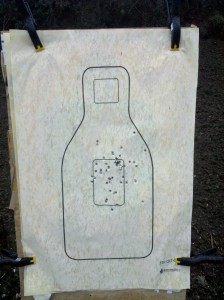Let’s start this blog post with a definition. Here is what I mean when I say a handgun is “too big” for someone’s hands.
1) If you cannot reliably reach all of the gun’s controls or make them work for you in an efficient way.
2) If you cannot flick the safety off with your dominant thumb, without shifting away from a good firing grip while you do it.
3) If you cannot keep the correct part of your finger on the trigger with the gun’s backstrap snugged into the web of your hand and the barrel aligned with your forearm bones.
(Read more about gun size here: finding a gun that fits your hands.)
When a handgun is too large for you, it does not mean you cannot shoot the gun at all. Obviously, you can! And you can enjoy it, too. But a self-defense gun should fit your hand as perfectly as possible.
Let me explain why this is.
First, if the gun does not naturally line up with your forearm bones, you will have trouble in less-than-ideal conditions because you cannot use your natural pointing instinct to bring the gun quickly onto target. Of course, you can still raise the gun quickly into your line of sight, but once the gun is in front of your face it will take you an extra moment to look for the front sight and then bring it over to where it’s supposed to be. That takes time—time that you may not have. It also requires good lighting conditions, which you may not have because crimes often happen in poorly-lit areas. With a gun that does fit you correctly, you simply bring the gun up, briefly glance at the sights to verify alignment, and take the shot. This takes much less time. It’s also much more reliable in dim light, or under other challenging conditions such as when you and your assailant are both moving.
When the gun is too big for your hands, it may be difficult for you to reach and use the controls under the best of times. It may be especially tricky if you need to run the gun with just one hand, such as you might need to do when fighting for your life.
Although you can become quite accurate with a gun that does not fit you well, you will never be able to shoot an oversized gun as fast and as well as you could shoot the same type of gun if it actually fit you. This is especially true if you need to shoot under maximum stress, or if you can’t see the sights as well as you’d like to see them.
Again, I’m not saying you can’t shoot an incorrectly sized gun at all, or that you won’t enjoy shooting it. I am simply saying that you can’t shoot an incorrectly-sized gun as fast, as accurately, or as reliably as you would be able to shoot one that fits you better.
If the gun doesn’t fit your hand that well, it doesn’t matter as long as it’s a gun you use only for pleasure shooting or for plinking. (D’oh! A gun you love is a gun you love…) But it does matter if you think you might ever need to shoot the gun in self defense. If you need to do that, you will want every advantage you can possibly get, including the advantage of a firearm you can easily control and that reliably lines up with the target using your natural pointing instinct.






